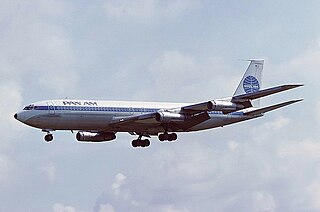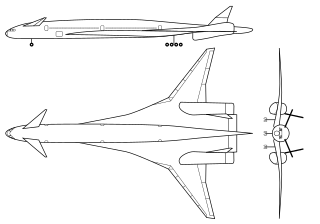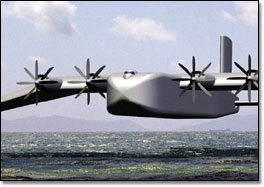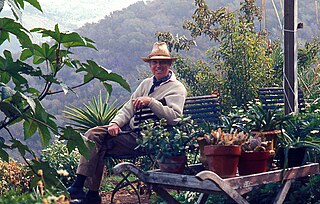History
Site
The property was formerly owned and occupied by famous artist and Hollywood set designer Tony Duquette. Duquette's property was burned in the Green Meadow fire of 1993, which resulted in the complete destruction of over twenty-one of the structures that he and his wife had created from recycled objects and movie sets. [1] [2]
Concept
Whilst flying in the air and pondering the design, Hertz imagined a floating roof that would hang over the site to minimize structural obstructions of the views of a nearby mountain ridge. Hertz's initial concept sketches showed a site section with a curved ceiling and a roof form that reminded him of the wing section of an airplane. The wing, a self-supporting structure, cantilevers off the fuselage of an airplane like an outstretched arm. This requires little vertical support and only a few walls, which is ideal for a structure to minimize obstructions and maximize views. [3] Creating a wing foil shaped roof would be complex and difficult to build conventionally. [3] Through examining and exploring a variety of actual wing dimensions, Hertz determined that the wings from a 747 would fit on the existing pads and that they were already oriented to keep the views. The low profile of the wings was integrated into the ridge top, and the wing made to appear to cascade down and float above the ground. Utilizing the wings as 100% post-consumer recycled components and appropriating them in creative new ways is consistent with the existing context of Duquette's structures of found objects and emblematic of Hertz's thoughts on the "disposable" nature of our society. [4]
Design
The main house comprises two separate buildings linked together on three levels and uses two wings and two horizontal stabilizers from a Boeing 747-100. The lower house is partially open air and has 18-foot-tall (5.5 m) ceilings topped with the left 747 wing. The upper structure creates the main house and uses the right wing as the main roof and two horizontal stabilizers as the roofs of the main bedroom and bathroom.
Execution
Hertz convinced the client to purchase the 747 airplane, originally worth about $25 million when Boeing completed it in 1970, for US$35,000. Mark Thompson of Thompson Aviation sold the airplane and his team detoxified, cut apart, and transported the plane for airlift. Using a laser and the cut-off saws at the Victorville Airport, home of the second largest airplane graveyard in the nation, the cockpit and tail were removed and the fuselage cut longitudinally. Next, transverse sectioning reduced large segments of fuselage and the wings to a manageable size for transport. A truck carried the parts, measuring 47 by 125 feet (14 by 38 m), successfully without damage. Seven California Highway Patrol vehicles escorted the truck during the night and closed multiple lanes of three major freeways, State Routes 2 and 15, and US Route 101, to accommodate the vehicle. The wings traveled from the Southern California Logistics Airport aircraft boneyard to Camarillo Airport in Camarillo, California, located 10 miles from the site. At that point, because each wing weighed approximately 20,000 lb (9,100 kg) and the only way to transport such heavy, unwieldy sections to a remote destination was from above (navigation by truck was deemed impossible), the wings needed to be cut in two for proper positioning for transport by helicopter, which was completed by a Columbia Model 234 operated by Columbia Helicopters Inc. of Portland, Oregon and took over two hours to complete. The helicopter positioned the wings on a large pile of tires at the site. The wings were then spliced back together and lifted onto columnar supports, attaching the custom fabricated steel brackets on the columns to the engine mounts on the wings. The wings touched the ground at few points creating minimal foundation requirements.
Environmental features
Hundreds of airplanes had been retired to sit in the deserts of California and sold at the price of their principal raw material, aluminum. The idea of utilizing recycled components and appropriating them in creative new ways was certainly consistent with the existing context of the original Tony Duquette structures and envisioned by architect Hertz as a continuum of that concept as appropriated to today's concerns regarding minimizing primary raw material use in buildings. [5]
The building is extremely light weight and features very few conventional materials. The main roof structure is almost entirely composed of the recycled wings. The use of the wings makes for a structure that uses materials more efficiently to achieve higher strength with less weight. Using the wings to achieve the curvilinear roof structure desired by the client saved a substantial amount of embodied energy, carbon dioxide output, and construction waste, compared to building a similar sized house made from conventional materials that would have to be transported up and down the mountain to the same location. Using the wing was also a substantial cost reduction. Even at $8–18,000 [6] per hour for the helicopter and $30,000 for the 747, it was still a fraction of the cost of building a similarly shaped roof with conventional materials. [7]
The 747 Wing House was built on the site where existing Duquette structures had burned. Some of the materials from the previous building were used as walkways. [8] The use of the existing pad minimized site grading. The foundation used many of the existing concrete retaining walls but they were rebuilt and reinforced as required to meet new code regulations. This greatly reduced the amount of concrete needed to make the foundation and new walls. Because the wings are only supported in four primary places to the ground, the foundation was further minimized. Both main wings are held up entirely by the four large mounts that the engines originally hung from. By designing the weight distribution on the mounts, it allowed for the outside walls of the building to be made of high efficiency self-supporting glass instead of conventional load-bearing wooden walls. This maximizes solar gain for heating and allows the entire building to be opened to the outside. This also keeps it cool in the summers and minimizes the need for artificial light. [5]
The home features an eight kilowatt solar array and a vacuum insulated hot water system as well as thermal solar systems for heating water. High performance glass and cellulose insulation is used in the wings to create an energy efficient building envelope.

An aircraft is a vehicle that is able to fly by gaining support from the air. It counters the force of gravity by using either static lift or the dynamic lift of an airfoil, or, in a few cases, direct downward thrust from its engines. Common examples of aircraft include airplanes, helicopters, airships, gliders, paramotors, and hot air balloons.

The Boeing 747 is a long-range wide-body airliner designed and manufactured by Boeing Commercial Airplanes in the United States between 1968 and 2023. After the introduction of the 707 in October 1958, Pan Am wanted a jet 2+1⁄2 times its size, to reduce its seat cost by 30%. In 1965, Joe Sutter left the 737 development program to design the 747. In April 1966, Pan Am ordered 25 Boeing 747-100 aircraft, and in late 1966, Pratt & Whitney agreed to develop the JT9D engine, a high-bypass turbofan. On September 30, 1968, the first 747 was rolled out of the custom-built Everett Plant, the world's largest building by volume. The 747's first flight took place on February 9, 1969, and the 747 was certified in December of that year. It entered service with Pan Am on January 22, 1970. The 747 was the first airplane called a "Jumbo Jet" as the first wide-body airliner.

Trans World Airlines Flight 800 (TW800/TWA800) was a Boeing 747-100 that exploded and crashed into the Atlantic Ocean near East Moriches, New York, on July 17, 1996, at approximately 8:31 p.m. EDT, 12 minutes after takeoff from John F. Kennedy International Airport, on a scheduled international passenger flight to Rome with a stopover in Paris.

A fixed-wing aircraft is a heavier-than-air flying machine, such as an airplane, which is capable of flight using aerodynamic lift. Fixed-wing aircraft are distinct from rotary-wing aircraft, and ornithopters. The wings of a fixed-wing aircraft are not necessarily rigid; kites, hang gliders, variable-sweep wing aircraft, and airplanes that use wing morphing are all classified as fixed wing.

A tiltrotor is an aircraft that generates lift and propulsion by way of one or more powered rotors mounted on rotating shafts or nacelles usually at the ends of a fixed wing. Almost all tiltrotors use a transverse rotor design, with a few exceptions that use other multirotor layouts.

The Boeing 707 is an early American long-range narrow-body airliner, the first jetliner developed and produced by Boeing Commercial Airplanes. Developed from the Boeing 367-80 prototype first flown in 1954, the initial 707-120 first flew on December 20, 1957. Pan Am began regular 707 service on October 26, 1958. With versions produced until 1979, the 707 is a swept wing quadjet with podded engines. Its larger fuselage cross-section allowed six-abreast economy seating, retained in the later 720, 727, 737, and 757 models.

The fuselage is an aircraft's main body section. It holds crew, passengers, or cargo. In single-engine aircraft, it will usually contain an engine as well, although in some amphibious aircraft the single engine is mounted on a pylon attached to the fuselage, which in turn is used as a floating hull. The fuselage also serves to position the control and stabilization surfaces in specific relationships to lifting surfaces, which is required for aircraft stability and maneuverability.

The Boeing Sonic Cruiser was a concept jet airliner with a delta wing–canard configuration. It was distinguished from conventional airliners by its delta wing and high-subsonic cruising speed of up to Mach 0.98. Boeing first proposed it in 2001, but airlines generally preferred lower operating costs over higher speed. Boeing ended the Sonic Cruiser project in December 2002 and shifted to the slower but more fuel-efficient 7E7 airliner.

An airplane or aeroplane, informally plane, is a fixed-wing aircraft that is propelled forward by thrust from a jet engine, propeller, or rocket engine. Airplanes come in a variety of sizes, shapes, and wing configurations. The broad spectrum of uses for airplanes includes recreation, transportation of goods and people, military, and research. Worldwide, commercial aviation transports more than four billion passengers annually on airliners and transports more than 200 billion tonne-kilometers of cargo annually, which is less than 1% of the world's cargo movement. Most airplanes are flown by a pilot on board the aircraft, but some are designed to be remotely or computer-controlled such as drones.

The Boeing Pelican ULTRA was a proposed ground effect fixed-wing aircraft under study by Boeing Phantom Works in the early 2000s.

A blended wing body (BWB), also known as blended body, hybrid wing body (HWB) or a lifting aerofoil fuselage, is a fixed-wing aircraft having no clear dividing line between the wings and the main body of the craft. The aircraft has distinct wing and body structures, which are smoothly blended together with no clear dividing line. This contrasts with a flying wing, which has no distinct fuselage, and a lifting body, which has no distinct wings. A BWB design may or may not be tailless.

The Boeing 747SP is a shortened version of the Boeing 747 wide-body airliner, designed for a longer range. It is the highest flying subsonic passenger airliner, with a service ceiling of 45,100 feet . Boeing needed a smaller aircraft to compete with the McDonnell Douglas DC-10 and Lockheed L-1011 TriStar tri-jet wide-bodies, introduced in 1971/1972. Pan Am requested a 747-100 derivative to fly between New York and the Middle East, a request also shared by Iran Air, and the first order came from Pan Am in 1973.

The TWA Flight Center, also known as the Trans World Flight Center, is an airport terminal and hotel complex at John F. Kennedy International Airport (JFK) in New York City. The original terminal building, or head house, operated as a terminal from 1962 to 2001 and was adaptively repurposed in 2017 as part of the TWA Hotel. The head house is partially encircled by a replacement terminal building completed in 2008, and flanked by two buildings added for the hotel. The replacement terminal is home to JetBlue's JFK operations. The head house and terminal are collectively known as Terminal 5 or T5.
An aerostructure is a component of an aircraft's airframe. This may include all or part of the fuselage, wings, or flight control surfaces. Companies that specialize in constructing these components are referred to as "aerostructures manufacturers", though many larger aerospace firms with a more diversified product portfolio also build aerostructures.

Anthony Duquette was an American artist who specialized in designs for stage and film.
An airplane house or aeroplane house is a residential home made from a retired or scrapped aircraft. The houses are usually old airliners that once carried passengers, but have now been sent to a scrap yard because of age or because of cuts in the airline's fleet.

The aircraft design process is a loosely defined method used to balance many competing and demanding requirements to produce an aircraft that is strong, lightweight, economical and can carry an adequate payload while being sufficiently reliable to safely fly for the design life of the aircraft. Similar to, but more exacting than, the usual engineering design process, the technique is highly iterative, involving high-level configuration tradeoffs, a mixture of analysis and testing and the detailed examination of the adequacy of every part of the structure. For some types of aircraft, the design process is regulated by civil airworthiness authorities.

David Randall Hertz is an American architect, inventor and educator. He is known for his work in sustainable architecture and as an early innovator in the development of recycled building materials.

The Aurora D8, also known as the D8 Airliner, is an airliner concept under development as of mid 2017. The project was initiated in 2008 by Aurora Flight Sciences, the Massachusetts Institute of Technology (MIT) and Pratt & Whitney under NASA's sponsorship of $2.9 million.
The Tupolev Tu-404 was a wide-body superjumbo blended wing jet airliner proposed by Russian aerospace company Tupolev.




























